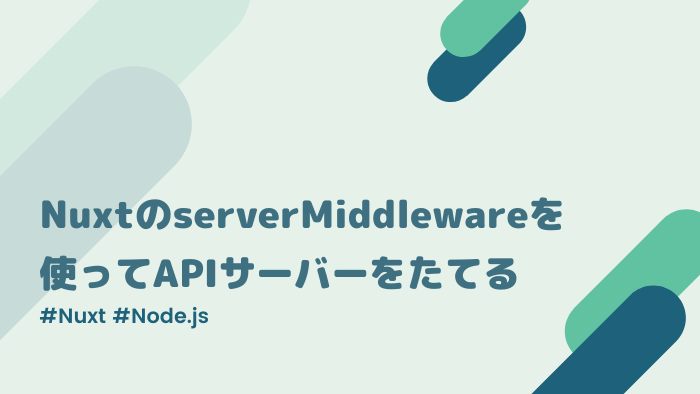どーも、ぐるたか@guru_takaです。
NuxtのserverMiddlewareを使って、APIサーバーを立てたので、そのやり方をまとめます。
MEMO
typescriptを使用しています。 serverMiddlewareとは?
serverMiddlewareについて簡単にまとめると、APIリクエストやアセットなどのサーバー固有の処理をやってくれます。
BFF(Backends For Frontends)のように使える優れものです!
参考 API: serverMiddleware プロパティ - NuxtJS 参考 Nuxtに「serverMiddleware」を設定して、API サーバ的な動きをさせてみた | 東京のWeb制作会社LIG主な手順
STEP.1
APIサーバー構築
STEP.2
nuxt.config.jsの編集STEP.3
axiosで確認
STEP.1:APIサーバー構築
expreeを使用して、APIサーバーを構築します。
まずはソースから!
import { Request, Response } from 'express'
const express = require('express')
const app = express()
// for parsing application/json
app.use(express.json())
// for parsing application/x-www-form-urlencoded
app.use(express.urlencoded({ extended: true }))
// post:オウム返し
app.post('/api/post', async (req: Request, res: Response) => {
await res.end(req.body.params.test)
})
// get:hello world
app.get('/api/get', (req: Request, res: Response) => {
res.send('hello world')
})
export default app
bodyParserを使ってパースする記事が多いですが、Express4.16以降からexpress搭載のメソッドでできるようになりました。
参考
Express 4.x - API リファレンス
ここでは、Hello WorldをGetできるAPIと、POSTでオウム返しするAPIをサンプルとして挙げています。
STEP.2:nuxt.config.jsの編集
続いて、nuxt.config.jsを以下のように追記します。
nuxt.config.js
serverMiddleware: ['~/api'],
STEP.3:axiosで確認
後は$ yarn devでローカル環境を立ち上げてみましょう。
すると、localhost:3000/api/getを開くと、Hello Worldが出てくるはずです!
Postについては、以下のコードで確認すると良いでしょう。
pages/ondex.vue
<script lang="ts">
import { Component, Vue } from 'vue-property-decorator'
@Component({
components: {
Logo: () => import('@/components/Logo.vue')
},
async asyncData({ app }) {
const posts = await app.$axios.$post('http://localhost:3000/api/post', {
params: { test: 'オウム返し' }
})
console.log(posts)
}
})
export default class Index extends Vue {}
</script>
MEMO
typescriptで@nuxt/axiosを使うときは、tsconfig.jsonに"types": ["@nuxtjs/axios"]を追加しないと、$axiosが使えなくなります!


コメントを残す